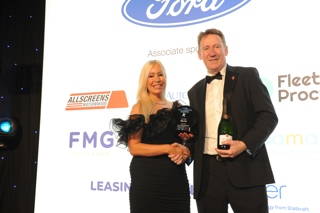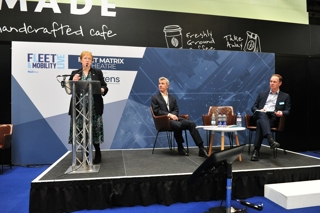Good evening and welcome to the unveiling of the 2011 FN50, the definitive list of the 50 biggest contract hire and leasing companies in the UK.
This year’s FN50 gives a hugely revealing insight into the health and condition of the leasing industry as you’ll see later on.
My thanks to Sewells Research & Insight and its research director John Maslen who collated all of the data for the FN50.
Their painstaking research and detailed analysis ensures that the FN50 remains the most accurate picture of today’s contract hire and leasing market.
Thanks also to our FN50 headline sponsor: Skoda UK for supporting the FN50 again this year.
And congratulations to Skoda too for defending its manufacturers’ title at the 2011 Inter-Continental Rally Challenge at the weekend.
Thanks also to our six FN50 associate sponsors: White Clarke Group, Michelin Tyre, Shell UK, Total Accident Management, Autoglass and Tracker.
Now, on to business. This year’s FN50 has arguably seen the biggest shake up since we expanded the listing from the FN40 in 1998.
Acquisitions, collapses and some mid-table movements have resulted in a fundamentally different top 50 compared to a year ago – and one that is considerably smaller.
Seven companies depart the list, although two have been absorbed into other FN50 operations - ING, now part of Alphabet, and Masterlease, now managed by Leasedrive.
Consequently, the FN50 risk fleet size has reduced by 4.4%, or 56,792 vehicles, to 1,242,503.
It’s the third consecutive year-on-year decline, and means the FN50 is now almost 17% below the 2008 peak of almost 1.5 million vehicles, equivalent to the loss of a quarter of a million vehicles.
This represents a fall of more than £3 billion in the total value of the assets they now operate, based on an average vehicle value of £12,000.
The last time the FN50 was smaller than this, we were all worrying about how the Millennium Bug would affect our computers.
But while this is the smallest FN50 for 12 years, it’s actually our biggest ever FN50 Dinner event with 850 people in the room.
Although the economy remains tough, the fact that so many of you are here tonight at what is the fleet industry’s premiere networking event is, I believe, a positive sign that business prospects are good.
It’s undoubtedly true that companies are buying cars and vans again.
This can be seen from the official registrations figures, which show van sales up year-to-date by 21% and true fleet car sales – which exclude rental, Motability and captives – up 11%.
In addition, FN50 data shows that, despite the challenging economic conditions, organisations have cut the length of time they retain cars although they are driving them further. Headline figures based on company car returns from the leasing companies for this year’s FN50 reveal that on average models are being operated for 36.8 months and 60,300 miles, compared with 37.6 months and 59,000 miles last year.
Vans, meanwhile are being replaced at an average 43.5 months or 77,600 miles.
The big debate on replacement is whether you extend cycles to benefit from a lower lease rate without detriment to service, maintenance and repair costs or vehicle downtime… or whether you reduce cycles in order to benefit from new technology which means better fuel efficiency, lower CO2 emissions and additional safety features.
Fleets are split but this is where total cost of ownership models with predictive capabilities can prove invaluable.
Our research with the Fleet200 suggests that the biggest fleets are favouring extending replacement cycles, although this is slightly skewed by those who outright purchase their vehicles where sweating the asset is a key business objective.
This year’s FN50 has seen the bigger companies strengthen their grip on the UK contract hire and leasing industry.
The top 25 now accounts for 94% of vehicles, leaving the remaining 25 companies to fight over 6% market share.
And within the top 25, the largest companies have consolidated their dominance of the table. The top 5 have increased their fleet size by 2.6% or 16,714 vehicles to just under 667,000.
The companies between sixth and 10th place have enjoyed even stronger growth of 9.4%, taking their fleet size to almost 261,000.
By comparison, every other part of the table has seen its fleet size fall this year.
In turn, this has had a significant impact on market share. The top five companies now account for just over half of vehicles operated by FN50 companies, with the next five running a further 21%.
The share of the smallest 20 companies, meanwhile, has been dropping steadily. In 2006, the bottom 20 accounted for 6.3% of the market, but this year the share has dropped below 5%.
All these companies are independent operators. Independents account for 22% of the FN50 fleet, including dealer owned groups who make up the smallest proportion, with 9.9% market share.
Manufacturer-owned groups account for 21% of the FN50 but by far the biggest share is taken by banks, which account for 57%, or 708,000 vehicles.
Bank-owned leasing companies tend to sit at the top end of the table and their ownership reflects the enormous funding requirements for operating at this level, where each company needs billions of pounds to fund the purchase of vehicles to be leased to customers.
In this industry that has a combined turnover of £4 billion a year, access to money is critical and any restriction has a direct and immediate impact on competitiveness.
To operate effectively, secure growth and enhance profitability, this supply of money needs to be unhindered and provided at competitive interest rates.
But as banks and funders have fled from risk during the global recession, their ability to supply contract hire companies with regular waves of capital, or supply the money at a low rate of interest, has been severely restricted.
Nearly two thirds of respondents to this year’s FN50 survey said that funding and a faltering economy was their number one concern, while 83% put it in their top three issues.
There is no sign that liquidity will be eased in the medium-term and access to competitive funding is probably the most significant issue affecting the shape of the leasing sector in the next three to five years, especially with a number of the major wholesaler funders exiting the market.
A number of leasing companies believe that the SME market will be hardest hit and businesses will consider extending contracts again.
Recent news regarding downbeat assessments of the global economy will further fan the flames of concern among businesses trying to get access to funding, particularly at affordable rates.
The answer for leasing companies is to begin the arduous search for new funding suppliers or try to build a larger supplier base to ensure interest rates are kept as competitive as possible.
Zenith is the first to try something different with the announcement of a new securitisation funding structure to protect its future growth plans.
It’s one of a number of leasing companies to express ambitious growth aspirations and no doubt we will evaluate the success of this in next year’s FN50.
But let’s now look at how the growth strategies of leasing companies have been executed over the past year and celebrate the companies that are in this room tonight….
Ladies and gentlemen, I give you the 2011 FN50.





















Login to comment
Comments
No comments have been made yet.